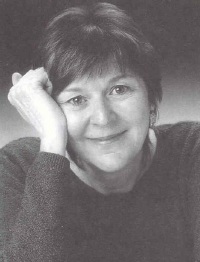Sierra, Judy
I have always loved poetry. My mother tells about a visit to the doctor when I was two years old: I astonished him by sitting on his lap and reciting a long poem by Robert Louis Stevenson. When I was six, my father began paying me a dollar for every poem I learned by heart. My favorites were “The Walrus and the Carpenter” from Lewis Carroll’s Alice in Wonderland and “The Rum Tum Tugger” from T.S. Eliot’s Old Possum’s Book of Practical Cats. As I was writing Antarctic Antics: A Book of Penguin Poems, I imagined it staged as a musical like Cats, which is based on Eliot’s poems.
By the time I was in second grade I was writing my school reports in rhyme. I also loved doing word puzzles and reading the dictionary. In high school, I had a wonderful creative writing teacher. I edited for the school literary magazine and drew cartoons for the newspaper.
Later, I wrote plays and adapted stories for children’s theater. Along with my husband, Bob Kaminski, I performed as a puppeteer and storyteller. We criss-crossed the country to visit schools, libraries, theaters and Renaissance festivals. We especially enjoyed presenting folktales with traditional shadow puppets, and our production of the Chinese story of Monkey King was featured at the Smithsonian Museum.
It was in 1986 that I attended my first children’s book writers’ conference. There, I heard a speech by the award-winning writer and illustrator Uri Shulevitz. He said that a picture book is a small theater for an adult and child to enjoy together. I thought to myself, “I know all about small theaters, and about entertaining children. I should write a picture book.” I began writing, and on my fourth attempt, I was published.
Some of my children’s books are original poetry, while others are retellings of traditional folktales. As a storyteller, I had become fascinated with folktales: Why was the same story told in far distant regions, with so many variations? Why were folktales so much fun to improvise upon? Why do children love them so much? To answer these questions, I studied folklore at UCLA, and received a Ph.D. in 1993. I try to incorporate what I learned in these studies to make my folktale books as authentic as possible. When I retell a folktale, I study the entire storytelling tradition of the culture as thoroughly as I can, and whenever possible I enlist people from that culture to help me recapture the feeling and meaning of a tale. I have to translate not only the words of the story, but the complete storytelling experience. In most cultures, storytelling is participatory, and I try to create texts that invite audience participation.
Needless to say, all of my writing for children is meant to be read aloud. I’m very happy if parents and children make up extra verses for my poems, or adapt my folktales to fit their way of seeing the world. I love the fact that the covers of many of my books-for example The House that Drac Built and Crocodiles, both illustrated by Will Hillenbrand-suggest stories that are not in the book. They can be used as story-starters for young imaginations.
My poetry book ideas come from looking at something ordinary in a new way. What if the house that Jack built was really the house that Drac built? What if penguins could talk and tell people about their lives? It takes an improbable but exciting idea like these to sustain me for the long time it takes me to write a book. With poetry especially, each word has to be just right. Although my poems feature end-rhyme, there is much more to my poetry than rhyme and meter. The sounds of the words within a line need to echo one another in interesting and surprising ways. I work on each poetry book for at least two years. Of course, I don’t work on a particular book every day. I set a manuscript aside from time to time, so that I can see it with a fresh and critical eye.
– Courtesy of Random House
Click here for titles available in the BTSB Bookstore from this author

